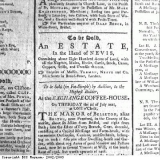The plantation economy
Land in the Caribbean islands was cheap, but the costs of setting up a sugar plantation were high. Sir Dalby Thomas in 1690 estimated that a 100 acre plantation on the island of Barbados, with 50 enslaved Africans, seven white indentured servants, sugar mill, boiling works, equipment and livestock would cost £5,625 (over £250,000 at today’s values). To recover these costs, the plantations had to produce enough good quality sugar to pay off debts and mortgages and cover the running costs each year. The owners also wanted a profit. Some families, such as the Pinneys of Nevis in the Caribbean and Bristol, were able to build up a fortune based on land, sugar producing and trading.
Slaves from Africa were the basis of these sugar fortunes. John Pinney, a plantation owner on the island of Nevis, wrote in the 1760s to his managers ‘� a word respecting the care of my slaves and stock [animals] – your own good sense must tell you they are the sinews of a Plantation and must claim your particular care and attention�. He also wrote that �� it is impossible for a Man to make sugar without the assistance of Negroes as to make bricks without straw’.
Enslaved Africans required a period of ‘seasoning’ to get them used to the work and the country. One in three of the newly imported slaves died within three years, and planters needed a continuous supply of new slaves. Before the 1760s, plantation life was particularly brutal. For although treatment did vary, it generally worked out cheaper for owners to work slaves to death and import new ones, rather than to look after those already on the plantations. John Newton was once a slave ship captain and later campaigned against the slave trade. He was told in 1751 by a plantation owner on the Caribbean island of Antigua, that the costs had been calculated and it was cheaper to work slaves to death and replace them than to treat them well. On some estates in Antigua, it was rare for a slave to live longer than nine years.
It was not just work that was hard for the enslaved Africans. The white population on the islands was outnumbered by the black population, and they were frightened of rebellion . Therefore, punishment for any breaking of the rules was harsh. Rebellion was usually punished by death, often by a slow and painful method, to deter any others who thought of rising up against their owners. The Session Book of the Parish of St Thomas in the East, Jamaica, for 1783, records the punishment handed out to a slave who tried to run away. It reads: �Priscilla: for running away, both her ears cut off … immediately, to receive 39 lashes the first Monday in each month for one year and to be worked in irons during this time�. It was a hard punishment for trying to be free. Flogging was commonplace, and slaves could be made to torture members of their own family if the owner or overseer so wished. Harsh laws were aimed at punishing any act of rebellion and discouraging others. In 1707, a law was passed on the island of Barbados, which said a runaway slave absent for more than 30 days should have one of his or her feet cut off when recaptured.
As a result of anti-slavery feeling in the late eighteenth century, and the rising price of African slaves, the more ‘progressive’ plantation owners saw the wisdom of treating their slaves better.



